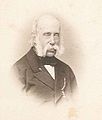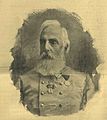House of Habsburg
This article contains too many pictures, charts or diagrams for its overall length. |
| House of Habsburg Haus Habsburg | |
|---|---|
| Imperial and Royal dynasty | |
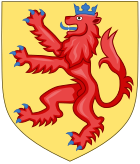 Coat of arms of the Counts of Habsburg | |
| Country | show
List |
| Etymology | Habsburg Castle |
| Founded | 11th century |
| Founder | Radbot of Klettgau |
| Current head | Karl von Habsburg (cognatic line) |
| Final ruler | Maria Theresa (agnatic line) Charles I (cognatic line) |
| Titles | show
List |
| Motto | A.E.I.O.U. and Viribus Unitis |
| Estate(s) |
|
| Dissolution | 29 November 1780 (in the agnatic line; still existing in a cognatic line) |
| Cadet branches | Agnatic: (all are extinct)
Cognatic:
|
The House of Habsburg (/ˈhæpsbɜːrɡ/; German: Haus Habsburg [ˈhaːpsbʊʁk] (![]() listen); Spanish: Casa de Habsburgo [aβzˈβuɾɣo]; Hungarian: Habsburg-család), also known as the House of Austria (German: Haus Österreich; Spanish: Casa de Austria),[3] was one of the most prominent royal houses of Europe in the 2nd millennium.
listen); Spanish: Casa de Habsburgo [aβzˈβuɾɣo]; Hungarian: Habsburg-család), also known as the House of Austria (German: Haus Österreich; Spanish: Casa de Austria),[3] was one of the most prominent royal houses of Europe in the 2nd millennium.
The house takes its name from Habsburg Castle, a fortress built in the 1020s in present-day Switzerland by Radbot of Klettgau, who named his fortress Habsburg. His grandson Otto II was the first to take the fortress name as his own, adding "Count of Habsburg" to his title. In 1273, Count Radbot's seventh-generation descendant Rudolph of Habsburg was elected King of the Romans. Taking advantage of the extinction of the Babenbergs and of his victory over Ottokar II of Bohemia at the battle on the Marchfeld in 1278, he subsequently moved the family's power base to Vienna, where the Habsburgs ruled until 1918.
The throne of the Holy Roman Empire was continuously occupied by the Habsburgs from 1440 until their extinction in the male line in 1740 and, after the death of Francis I, from 1765 until its dissolution in 1806. The house also produced kings of Bohemia, Hungary, Croatia, Spain, Portugal and Galicia-Lodomeria, with their respective colonies; rulers of several principalities in the Low Countries and Italy; and in the 19th century, emperors of Austria and of Austria-Hungary as well as one emperor of Mexico. The family split several times into parallel branches, most consequentially in the mid-16th century between its Spanish and Austrian branches following the abdication of Charles V. Although they ruled distinct territories, the different branches nevertheless maintained close relations and frequently intermarried.
The house of Habsburg still exists and owns the Austrian branch of the Order of the Golden Fleece and the Imperial and Royal Order of Saint George. As of early 2021, the head of the family is Karl von Habsburg.
Name[]
The origins of Habsburg Castle's name are uncertain. There is disagreement on whether the name is derived from the High German Habichtsburg (hawk castle), or from the Middle High German word hab/hap meaning ford, as there is a river with a ford nearby. The first documented use of the name by the dynasty itself has been traced to the year 1108.[4][5][6]
The Habsburg name was not continuously used by the family members, since they often emphasized their more prestigious princely titles. The dynasty was thus long known as the "house of Austria". Complementarily, in some circumstances the family members were identified by their place of birth. Charles V was known in his youth after his birthplace as Charles of Ghent. When he became king of Spain he was known as Charles of Spain, and after he was elected emperor, as Charles V (in French, Charles Quint).
In Spain, the dynasty was known as the Casa de Austria, including illegitimate sons such as John of Austria and John Joseph of Austria. The arms displayed in their simplest form were those of Austria, which the Habsburgs had made their own, at times impaled with the arms of the Duchy of Burgundy (ancient).
After Maria Theresa married Duke Francis Stephen of Lorraine, the idea of "Habsburg" as associated with ancestral Austrian rulership was used to show that the old dynasty continued as did all its inherited rights. When Francis I became Emperor of Austria, he adopted the old shield of Habsburg in his personal arms, together with Austria and Lorraine. This also reinforced the "Germanness" of the (French-speaking) Austrian Emperor and his claim to rule in Germany, not least against the Prussian Kings. Some younger sons who had no prospects of the throne were given the personal title of "count of Habsburg".
The surname of more recent members of the family such as Otto von Habsburg and Karl von Habsburg is taken to be "von Habsburg" or more completely "von Habsburg-Lothringen". Princes and members of the house use the tripartite arms adopted in the 18th century by Francis Stephen.
History[]
| History of Austria |
|---|
 |
|
|
Counts of Habsburg[]
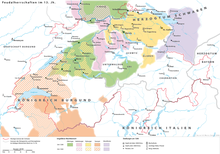
The progenitor of the House of Habsburg may have been Guntram the Rich, a count in the Breisgau who lived in the 10th century, and forthwith farther back as the medieval Adalrich, Duke of Alsace, from the Etichonids from which Habsburg derives. His grandson Radbot of Klettgau founded the Habsburg Castle. That castle was the family seat during most of the 11th, 12th and 13th centuries.
In the 12th century, the Habsburgs became increasingly associated with the Staufer Emperors, participating in the imperial court and the Emperor's military expeditions; Werner II, Count of Habsburg died fighting for Emperor Frederick I Barbarossa in Italy. This association helped them to inherit many domains as the Staufers caused the extinction of many dynasties, some of which the Habsburgs were heirs to. In 1198, Rudolf II, Count of Habsburg fully dedicated the dynasty to the Staufer cause by joining the Ghibellines and funded the Staufer emperor Frederick II's war for the throne in 1211. The emperor was made godfather to his newly born grandson, the future king Rudolf.[7][8]
The Habsburgs expanded their influence through arranged marriages and incestuous relations with family royalty and by gaining political privileges, especially countship rights in Zürichgau, Aargau and Thurgau. In the 13th century, the house aimed its marriage policy at families in Upper Alsace and Swabia. They were also able to gain high positions in the church hierarchy for their members. Territorially, they often profited from the extinction of other noble families such as the House of Kyburg.[9][10]
Pivot to Eastern Alpine Duchies[]
By the second half of the 13th century, count Rudolph IV (1218–1291) had become an influential territorial lord in the area between the Vosges Mountains and Lake Constance. On 1 October 1273, he was elected as a compromise candidate as King of the Romans and received the name Rudolph I of Germany.[9] He then led a coalition against king Ottokar II of Bohemia who had taken advantage of the Great Interregnum in order to expand southwards, taking over the respective inheritances of the Babenberg (Austria, Styria, Savinja) and of the Spanheim (Carinthia and Carniola). In 1278, Rudolph and his allies defeated and killed Ottokar at the Battle of Marchfeld, and the lands he had acquired reverted to the German crown. With the Georgenberg Pact of 1286, Rudolph secured for his family the duchies of Austria and Styria. The southern portions of Ottokar's former realm, Carinthia, Carniola, and Savinja, went to Rudolph's allies from the House of Gorizia.[11][12]
Following Rudolph's death in 1291, Albert I's assassination in 1308, and Frederick the Fair's failure to secure the German/Imperial crown for himself, the Habsburgs temporarily lost their supremacy in the Empire. In the early 14th century they also focused on the Kingdom of Bohemia. After Václav III’s death on 4 August 1306, there were no male heirs remaining in the Přemyslid dynasty. Habsburg scion Rudolph I was then elected but only lasted a year. The Bohemian kingship was an elected position,[13] and the Habsburgs were only able to secure it on a hereditary basis much later in 1626, following their submission of the Czech lands during the Thirty Years' War. After 1307, subsequent Habsburg attempts to gain the Bohemian crown were frustrated first by Henry of Bohemia (a member of the House of Gorizia) and then by the House of Luxembourg.
Instead, they were able to expand southwards: in 1311, they took over Savinja; after the death of Henry in 1335, they assumed power in Carniola and Carinthia; and in 1369, they succeeded his daughter Margaret in Tyrol. After the death of Albert III of Gorizia in 1374, they gained a foothold at Pazin in central Istria, followed by Trieste in 1382. Meanwhile, the original home territories of the Habsburgs in what is now Switzerland, including the Aargau with Habsburg Castle, were lost in the 14th century to the expanding Swiss Confederacy after the battles of Morgarten (1315) and Sempach (1386). Habsburg Castle itself was finally lost to the Swiss in 1415.
Albertinian / Leopoldian split and Imperial elections[]
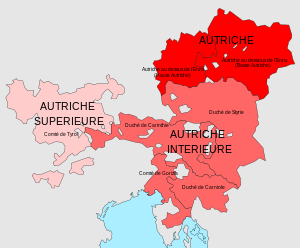
Rudolf IV's brothers Albert III and Leopold III ignored his efforts to preserve the integrity of the family domains, and enacted the separation of the so-called Albertinian and Leopoldian family lines on 25 September 1379 by the Treaty of Neuberg. The former would maintain Austria proper (then called Niederösterreich but comprising modern Lower Austria and most of Upper Austria), while the latter would rule over lands then labeled Oberösterreich, namely Inner Austria (Innerösterreich) comprising Styria, Carinthia and Carniola, and Further Austria (Vorderösterreich) consisting of Tyrol and the western Habsburg lands in Alsace and Swabia.[9]
By marrying Elisabeth of Luxembourg, the daughter of Emperor Sigismund in 1437, Duke Albert V of the Albertine line (1397–1439) became the ruler of Bohemia and Hungary, again expanding the family's political horizons. The next year, Albert was crowned as King of the Romans, known as such as Albert II. Following his early death in a battle against the Ottomans in 1439 and that of his son Ladislaus Postumus in 1457, the Habsburgs lost Bohemia once more as well as Hungary, for several decades. However, with the extinction of the House of Celje in 1456 and the House of Wallsee-Enns in 1466/1483, they managed to absorb significant secular enclaves within their territories, and create a contiguous domain stretching from the border with Bohemia to the Adriatic sea.
After the death of Leopold's eldest son William in 1406, the Leopoldian line was further split among his brothers into the Inner Austrian territory under Ernest the Iron and a Tyrolean/Further Austrian line under Frederick of the empty pockets. In 1440, Ernest's son Frederick III was chosen by the electoral college to succeed Albert II as the king. Several Habsburg kings had attempted to gain the imperial dignity over the years, but success finally arrived on 19 March 1452, when Pope Nicholas V crowned Frederick III as the Holy Roman Emperor in a grand ceremony held in Rome. In Frederick III, the Pope found an important political ally with whose help he was able to counter the conciliar movement.[9]
While in Rome, Frederick III married Eleanor of Portugal, enabling him to build a network of connections with dynasties in the west and southeast of Europe. Frederick was rather distant to his family; Eleanor, by contrast, had a great influence on the raising and education of Frederick's children and therefore played an important role in the family's rise to prominence. After Frederick III's coronation, the Habsburgs were able to hold the imperial throne almost continuously until 1806.[9]
Archdukes[]
Through the forged document called privilegium maius (1358/59), Duke Rudolf IV (1339–1365) introduced the title of Archduke to place the Habsburgs on a par with the Prince-electors of the Empire, since Emperor Charles IV had omitted to give them the electoral dignity in his Golden Bull of 1356. Charles, however, refused to recognize the title, as did his immediate successors.
Duke Ernest the Iron and his descendants unilaterally assumed the title "archduke". That title was only officially recognized in 1453 by Emperor Frederick III, himself a Habsburg.[14] Frederick himself used just "Duke of Austria", never Archduke, until his death in 1493. The title was first granted to Frederick's younger brother, Albert VI of Austria (died 1463), who used it at least from 1458. In 1477, Frederick granted the title archduke to his first cousin Sigismund of Austria, ruler of Further Austria. Frederick's son and heir, the future Emperor Maximilian I, apparently only started to use the title after the death of his wife Mary of Burgundy in 1482, as Archduke never appears in documents issued jointly by Maximilian and Mary as rulers in the Low Countries (where Maximilian is still titled "Duke of Austria"). The title appears first in documents issued under the joint rule of Maximilian and Philip (his under-age son) in the Low Countries.
Archduke was initially borne by those dynasts who ruled a Habsburg territory, i.e., only by males and their consorts, appanages being commonly distributed to cadets. These "junior" archdukes did not thereby become independent hereditary rulers, since all territories remained vested in the Austrian crown. Occasionally a territory might be combined with a separate gubernatorial mandate ruled by an archducal cadet. From the 16th century onward, archduke and its female form, archduchess, came to be used by all the members of the House of Habsburg (e.g., Queen Marie Antoinette of France was born Archduchess Maria Antonia of Austria.
Re-unification and expansion[]
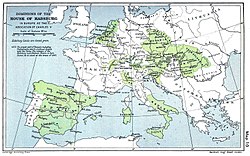
In 1457 Duke Frederick V of Inner Austria also gained the Austrian archduchy after his Albertine cousin Ladislaus the Posthumous had died without issue. 1490 saw the reunification of all Habsburg lines when Archduke Sigismund of Further Austria and Tyrol resigned in favor of Frederick's son Maximilian I.
As emperor, Frederick III took a leading role inside the family and positioned himself as the judge over the family's internal conflicts, often making use of the privilegium maius. He was able to restore the unity of the house's Austrian lands, as the Albertinian line was now extinct. Territorial integrity was also strengthened by the extinction of the Tyrolean branch of the Leopoldian line. Frederick's aim was to make Austria a united country, stretching from the Rhine to the Mur and Leitha.[9]
On the external front, one of Frederick's main achievements was the Siege of Neuss (1474–75), in which he coerced Charles the Bold of Burgundy to give his daughter Mary of Burgundy as wife to Frederick's son Maximilian.[9] The wedding took place on the evening of 16 August 1477 and ultimately resulted in the Habsburgs acquiring control of the Low Countries. After Mary's early death in 1482, Maximilian attempted to secure the Burgundian heritance to one of his and Mary's children Philip the Handsome. Charles VIII of France contested this, using both military and dynastic means, but the Burgundian succession was finally ruled in favor of Philip in the Treaty of Senlis in 1493.[15]
After the death of his father in 1493, Maximilian was proclaimed the new King of the Romans, receiving the name Maximilian I. Maximilian was initially unable to travel to Rome to receive the Imperial title from the Pope, due to opposition from Venice and from the French who were occupying Milan, as well a refusal from the Pope due to enemy forces being present on his territory. In 1508, Maximilian proclaimed himself as the "chosen Emperor," and this was also recognized by the Pope due to changes in political alliances. This had a historical consequence in that, in the future, the Roman King would also automatically become Emperor, without needing the Pope's consent. Emperor Charles V would be the last to be crowned by the Pope himself, at Bologna in 1530.[15]
Maximilian's rule (1493–1519) was a time of dramatic expansion for the Habsburgs. In 1497, Maximilian's son Philip, known as the Handsome or the Fair, married Joanna of Castile, also known as Joan the Mad, heiress of the Castile. Phillip and Joan had six children, the eldest of whom became Emperor Charles V and ruled the kingdoms of Castile and Aragon (including their colonies in the New World), Southern Italy, Austria, and the Low Countries.[16]
The foundations for the later empire of Austria-Hungary were laid in 1515 by the means of a double wedding between Louis, only son of Vladislaus II, King of Bohemia and Hungary, and Maximilian's granddaughter Mary; and between her brother Archduke Ferdinand and Louis's sister Anna. The wedding was celebrated in grand style on 22 July 1515. All these children were still minors, so the wedding was formally completed in 1521. Vladislaus died on 13 March 1516, and Maximilian died on 12 January 1519, but the latter's designs were ultimately successful: upon Louis's death in battle in 1526, Ferdinand became king of Bohemia and Hungary.
The Habsburg dynasty achieved its highest position when Charles V was elected Holy Roman Emperor. Much of Charles's reign was dedicated to the fight against Protestantism, which led to its eradication throughout vast areas under Habsburg control.
Spanish and Austrian Habsburgs[]

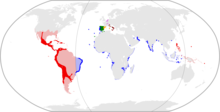
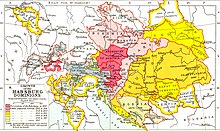
After the abdication of Charles V in 1556, the Habsburg dynasty split into the branch of the Austrian (or German) Habsburgs, led by Ferdinand, and the branch of the Spanish Habsburgs, initially led by Charles's son Philip.[17] Ferdinand I, King of Bohemia, Hungary,[18] and archduke of Austria in the name of his brother Charles V became suo jure monarch as well as the Habsburg Holy Roman Emperor (designated as successor already in 1531). Philip became King of Spain and its colonial empire as Philip II, and ruler of the Habsburg domains in Italy and the Low Countries. The Spanish Habsburgs also ruled Portugal for a time, known there as the Philippine dynasty (1580–1640).
The Seventeen Provinces and the Duchy of Milan were in personal union under the King of Spain, but remained part of the Holy Roman Empire. Furthermore, the Spanish king had claims on Hungary and Bohemia. In the secret Oñate treaty of 29 July 1617, the Spanish and Austrian Habsburgs settled their mutual claims.
Habsburg inbreeding and extinction of the male lines[]
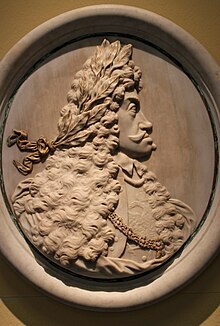
The Habsburgs sought to consolidate their power by frequent consanguineous marriages, resulting in a cumulatively deleterious effect on their gene pool. Health impairments due to inbreeding included epilepsy, insanity and early death. A study of 3,000 family members over 16 generations by the University of Santiago de Compostela suggests inbreeding may have played a factor in their extinction.[19] Numerous members of the family showed specific facial deformities: an enlarged lower jaw with an extended chin known as mandibular prognathism or "Habsburg jaw", a large nose with hump and hanging tip ("Habsburg nose"), and an everted lower lip ("Habsburg lip"). The latter two are signs of maxillary deficiency. A 2019 study found that the degree of mandibular prognasthism in the Habsburg family shows a statistically significant correlation with the degree of inbreeding. A correlation between maxillary deficiency and degree of inbreeding was also present but was not statistically significant.[20][21] Other scientific studies, however, dispute the ideas of any linkage between fertility and consanguinity.[22]
The gene pool eventually became so small that the last of the Spanish line, Charles II, who was severely disabled from birth, perhaps by genetic disorders, possessed a genome comparable to that of a child born to a brother and sister, as did his father, probably because of "remote inbreeding".[23][19]
The death of Charles II of Spain in 1700 led to the War of the Spanish Succession, and that of Emperor Charles VI in 1740 led to the War of the Austrian Succession. In the former, the House of Bourbon won the conflict and put a final end to the Habsburg rule in Spain. The latter, however, was won by Maria Theresa and led to the succession of the House of Habsburg-Lorraine (German: Haus Habsburg-Lothringen) becoming the new main branch of the dynasty, in the person of Maria Theresa's son, Joseph II. This new House was created by the marriage between Maria Theresa of Habsburg and Francis Stephan, Duke of Lorraine[24] (both of them were great-grandchildren of Habsburg emperor Ferdinand III, but from different empresses) being this new House a cadet branch of the female line of the House of Habsburg and the male line of the House of Lorraine. It is thought that extensive intra-family marriages within Spanish and Austrian lines contributed to the extinction of the main line.
House of Habsburg-Lorraine[]
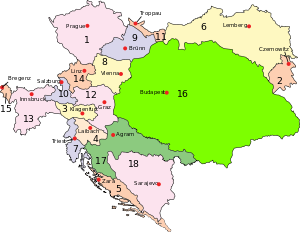 Kingdoms and countries of Austria-Hungary: Cisleithania (Empire of Austria[25]): 1. Bohemia, 2. Bukovina, 3. Carinthia, 4. Carniola, 5. Dalmatia, 6. Galicia, 7. Küstenland, 8. Lower Austria, 9. Moravia, 10. Salzburg, 11. Silesia, 12. Styria, 13. Tirol, 14. Upper Austria, 15. Vorarlberg; Transleithania (Kingdom of Hungary[25]): 16. Hungary proper 17. Croatia-Slavonia; 18. Bosnia and Herzegovina (Austro-Hungarian condominium) |
On 6 August 1806, Emperor Francis I dissolved the Holy Roman Empire under pressure from Napoleon's reorganization of Germany. In anticipation of the loss of his title of Holy Roman Emperor, Francis had declared himself hereditary Emperor of Austria (as Francis I) on 11 August 1804, three months after Napoleon had declared himself Emperor of the French on 18 May 1804.
Emperor Francis I of Austria used the official full list of titles: "We, Francis the First, by the grace of God, Emperor of Austria; King of Jerusalem, Hungary, Bohemia, Dalmatia, Croatia, Slavonia, Galicia and Lodomeria; Archduke of Austria; Duke of Lorraine, Salzburg, Würzburg, Franconia, Styria, Carinthia, and Carniola; Grand Duke of Cracow; Grand Prince of Transylvania; Margrave of Moravia; Duke of Sandomir, Masovia, Lublin, Upper and Lower Silesia, Auschwitz and Zator, Teschen, and Friule; Prince of Berchtesgaden and Mergentheim; Princely Count of Habsburg, Gorizia, and Gradisca and of the Tyrol; and Margrave of Upper and Lower Lusatia and Istria".
The Austro-Hungarian Compromise of 1867 created a real union, whereby the Kingdom of Hungary was granted co-equality with the Empire of Austria, that henceforth didn't include the Kingdom of Hungary as a crownland anymore. The Austrian and the Hungarian lands became independent entities enjoying equal status.[26] Under this arrangement, the Hungarians referred to their ruler as king and never emperor (see k. u. k.). This prevailed until the Habsburgs' deposition from both Austria and Hungary in 1918 following defeat in World War I.

On 11 November 1918, with his empire collapsing around him, the last Habsburg ruler, Charles I of Austria (who also reigned as Charles IV of Hungary) issued a proclamation recognizing Austria's right to determine the future of the state and renouncing any role in state affairs. Two days later, he issued a separate proclamation for Hungary. Even though he did not officially abdicate, this is considered the end of the Habsburg dynasty.
In 1919, the new republican Austrian government subsequently passed a law banishing the Habsburgs from Austrian territory until they renounced all intentions of regaining the throne and accepted the status of private citizens. Charles made several attempts to regain the throne of Hungary, and in 1921 the Hungarian government passed a law that revoked Charles' rights and dethroned the Habsburgs. The Habsburgs did not formally abandon all hope of returning to power until Otto von Habsburg, the eldest son of Charles I, on 31 May 1961 renounced all claims to the throne.
In the interwar period, the House of Habsburg was a vehement opponent of National Socialism and Communism. In Germany, Adolf Hitler diametrically opposed the centuries-old Habsburg principles of largely allowing local communities under their rule to maintain traditional ethnic, religious and language practices, and he bristled with hatred against the Habsburg family. During the Second World War there was a strong Habsburg resistance movement in Central Europe, which was radically persecuted by the Nazis and the Gestapo. The unofficial leader of these groups was Otto von Habsburg, who campaigned against the Nazis and for a free Central Europe in France and the United States. Most of the resistance fighters, such as Heinrich Maier, who successfully passed on production sites and plans for V-2 rockets, Tiger tanks and aircraft to the Allies, were executed. The Habsburg family played a leading role in the fall of the Iron Curtain and the collapse of the Communist Eastern Bloc.[27][28][29][30][31]
Multilingualism[]

As they accumulated crowns and titles, the Habsburgs developed a unique family tradition of multilingualism that evolved over the centuries. The Holy Roman Empire had been multilingual from the start, even though most of its emperors were native German-speakers.[32] The language issue within the Empire became gradually more salient as the non-religious use of Latin declined and that of national languages gained prominence during the High Middle Ages. Emperor Charles IV of Luxembourg was known to be fluent in Czech, French, German, Italian and Latin.[33]
The last section of his Golden Bull of 1356 specifies that the Empire's secular prince-electors "should be instructed in the varieties of the different dialects and languages" and that "since they are expected in all likelihood to have naturally acquired the German language, and to have been taught it from their infancy, [they] shall be instructed in the grammar of the Italian and Slavic tongues, beginning with the seventh year of their age so that, before the fourteenth year of their age, they may be learned in the same".[34] In the early 15th century, Strasbourg-based chronicler Jakob Twinger von Königshofen asserted that Charlemagne had mastered six languages, even though he had a preference for German.[32]:306
In the early years of the family's ascendancy, neither Rudolf I nor Albert I appear to have spoken French.[32]:278 By contrast, Charles V of Habsburg is well known some having been fluent in several languages. He was native in French and also knew Dutch from his youth in Flanders. He later added some Castilian Spanish, which he was required to learn by the Castilian Cortes Generales. He could also speak some Basque, acquired by the influence of the Basque secretaries serving in the royal court.[35] He gained a decent command of German following the Imperial election of 1519, though he never spoke it as well as French.[36] A witticism sometimes attributed to Charles was: "I speak Spanish/Latin [depending on the source] to God, Italian to women, French to men and German to my horse."[37]
Latin was the administrative language of the Empire until the aggressive promotion of German by Joseph II in the late 18th century, which was partly reversed by his successors. From the 16th century, most if not all Habsburgs spoke French as well as German, and many also spoke Italian.[citation needed] Ferdinand I, Maximilian II and Rudolf II addressed the Bohemian Assembly in Czech, even though it is not clear that they were fluent. By contrast, there is little evidence that later Habsburgs in the 17th and 18th centuries spoke Czech, with the probable exception of Ferdinand III who made several stays in Bohemia and appears to have spoken Czech while there. In the 19th century, Francis I had notions of Czech, and Ferdinand I spoke it decently.[38] Maximilian II spoke Spanish, Latin, Hungarian and Italian in addition to French and German and his above-mentioned notions of Czech. Maria Theresa spoke German, Italian, French, Spanish, Latin, and added Hungarian before she became Empress.[39]
Franz Joseph received a bilingual early education in French and German, then added Czech and Hungarian and later Italian and Polish. He also learned Latin and Greek.[40] Even so, he viewed himself as German, and once wrote to Napoleon III "Nein, ich bin ein Deutscher Fürst".[41] After the end of the Habsburg Monarchy, Otto von Habsburg was fluent in English, French, German, Hungarian, Italian, Spanish and Portuguese.[42]
Residences[]

Habsburg Castle, Aargau, Switzerland


Linz Castle

Hofburg Palace, Vienna

Hofburg, Innsbruck

Palace of Charles V, Granada
Palace of Margaret of Austria in Mechelen
Prague Castle

Bratislava Castle

Royal Palace of Milan

Royal Palace of Naples

El Escorial Palace near Madrid
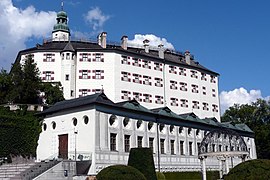
Ambras Castle, Innsbruck
Neugebäude Palace near Vienna

Buda Castle

Royal Palace of Gödöllő near Budapest
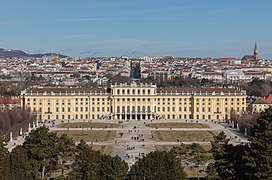
Schönbrunn Palace, Vienna
Hetzendorf Palace, Vienna

Palace of Charles of Lorraine in Brussels

Royal Villa of Monza

Habsburg Hunting Palace in Cieszyn, Poland
Habsburg Palace in Żywiec, Poland

Palais Erzherzog Wilhelm in Vienna
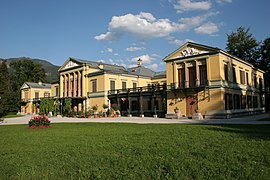
Kaiservilla in Bad Ischl, Austria
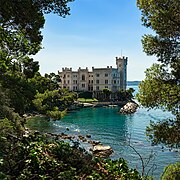
Miramare Castle, Trieste

Villa Wartholz, Reichenau an der Rax
Hermesvilla in Vienna

Konopiště Castle near Benešov, Czechia

Achilleion Palace in Corfu

Schloss Wilhelminenberg, Vienna

Casa Austria () outside Salzburg
Burials[]
This section is empty. You can help by . (September 2018) |
List of Habsburg rulers[]
The Habsburgs' monarchical positions included:
- Holy Roman Emperors (intermittently from 1273 until 1806) and Roman-German kings[43]
- Rulers of Austria (as dukes from 1278 until 1453; as archdukes from 1453 and as emperors from 1804 until 1918)
- Kings of Bohemia (1306–1307, 1437–1439, 1453–1457, 1526–1918)
- Kings of Spain (1516–1700)
- Kings of Hungary and Croatia (1526–1918)
- King of England and Ireland (1554-1558)[note 1][44]
- Kings of Portugal (1581–1640)
- Grand princes of Transylvania (1690–1867)
- Kings of Galicia and Lodomeria (1772–1918)
- Emperor of Mexico (1864–1867)
Ancestors[]
- Guntram the Rich (ca. 930–985 / 990) Father of:[45] The chronology of the Muri Abbey, burial place of the early Habsburgs, written in the 11th century, states that Guntramnus Dives (Guntram the Rich), was the ancestor of the House of Habsburg. Many historians believe this indeed makes Guntram the progenitor of the House of Habsburg. However, this account was 200 years after the fact, and much about him and the origins of the Habsburgs is uncertain.[46] If true, as Guntram was a member of the Etichonider family, it would link the Habsburg lineage to this family.
- of Altenburg (died 991). Besides Radbot, below, he had sons named , Wernher, and Landolf.
Before the Albertine/Leopoldine division[]
Counts[]
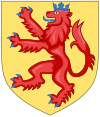
Before Rudolph rose to German king, the Habsburgs were Counts of Baden in what is today southwestern Germany and Switzerland.[45]
- Radbot of Klettgau, built the Habsburg Castle (c. 985 – 1035). Besides Werner I, he had two other sons: , who would become Count of Sundgau in the Alsace, and . Founded the Muri Abbey, which became the first burial place of members of the House of Habsburg. It is possible that Radbot founded the castle Habichtsburg, the residence of the House of Habsburg, but another possible founder is Werner I.[47]
- Werner I, Count of Habsburg (1025/1030–1096). Besides Otto II, there was another son, , who was reeve of Muri from 1111–1141 after the death of Otto II.
- Otto II of Habsburg; first to name himself as "of Habsburg"[48] (died 1111) Father of:
- Werner II of Habsburg (around 1135; died 1167) Father of:
- Albrecht III of Habsburg (the Rich), died 1199. Under him, the Habsburg territories expanded to cover most of what is today the German-speaking part of Switzerland. Father of:
- Rudolph II of Habsburg (b. c. 1160, died 1232) Father of:
- Albrecht IV of Habsburg, (died 1239 / 1240); father of Rudolph IV of Habsburg, who would later become king Rudolph I of Germany. Between Albrecht IV and his brother , the Habsburg properties were split, with Albrecht keeping the Aargau and the western parts, the eastern parts going to Rudolph III. Albrecht IV was also a mutual ancestor of Sophia Chotek and of her husband Archduke Franz Ferdinand of Austria
Kings of the Romans[]
- Rudolph I, emperor 1273–1291 (never crowned)

- Albert I, emperor 1298–1308 (never crowned)

King of Bohemia[]
- Rudolph I, king of Bohemia 1306–1307
Dukes/Archdukes of Austria[]
- Rudolph II, son of Rudolph I, duke of Austria and Styria together with his brother 1282–1283, was dispossessed by his brother, who eventually would be murdered by one of Rudolph's sons.
- Albert I (Albrecht I), son of Rudolph I and brother of the above, duke from 1282–1308; was Holy Roman Emperor from 1298–1308. See also below.
- Rudolph III, the oldest son of Albert I, designated duke of Austria and Styria 1298–1307
- Frederick the Handsome (Friedrich der Schöne), brother of Rudolph III. Duke of Austria and Styria (with his brother Leopold I) from 1308–1330; officially co-regent of the emperor Louis IV since 1325, but never ruled.
- Leopold I, brother of the above, duke of Austria and Styria from 1308–1326.
- Albert II (Albrecht II), brother of the above, duke of Further Austria from 1326–1358, duke of Austria and Styria 1330–1358, duke of Carinthia after 1335.
- Otto the Jolly (der Fröhliche), brother of the above, duke of Austria and Styria 1330–1339 (together with his brother), duke of Carinthia after 1335.
- Rudolph IV the Founder (der Stifter), oldest son of Albert II. Duke of Austria and Styria 1358–1365, Duke of Tirol after 1363.
Division of Albertinian and Leopoldian lines[]
After the death of Rudolph IV, his brothers Albert III and Leopold III ruled the Habsburg possessions together from 1365 until 1379, when they split the territories in the Treaty of Neuberg, Albert keeping the Duchy of Austria and Leopold ruling over Styria, Carinthia, Carniola, the Windic March, Tirol, and Further Austria.
Kings of the Romans and Holy Roman Emperors (Albertinian line)[]
- Albert II, emperor 1438–1439 (never crowned) -ancestor of Empress Catherine II of Russia

- Frederick III, emperor 1440–1493

Kings of Hungary and Bohemia (Albertinian line)[]
- Albert, king of Hungary and Bohemia (1437–1439)

- Ladislaus V Posthumus, king of Hungary (1444–1457) and Bohemia (1453–1457)

Kings of Bohemia (Albertinian line)[]
- Albert, king of Bohemia 1438–1439
- Ladislaus Posthumus, king of Bohemia 1453–1457
Dukes of Austria (Albertinian line)[]
- Albert III (Albrecht III), duke of Austria until 1395, from 1386 (after the death of Leopold) until 1395 also ruled over the latter's possessions.
- Albert IV (Albrecht IV), duke of Austria 1395–1404, in conflict with Leopold IV.
- Albert V (Albrecht V), duke of Austria 1404–1439, Holy Roman Emperor from 1438–1439 as Albert II. See also below.
- Ladislaus Posthumus, son of the above, duke of Austria 1440–1457.
Dukes of Styria, Carinthia, Tyrol / Inner Austria (Leopoldian line)[]
- Leopold III, duke of Styria, Carinthia, Tyrol, and Further Austria until 1386, when he was killed in the Battle of Sempach.
- William (Wilhelm), son of the above, 1386–1406 duke in Inner Austria (Carinthia, Styria)
- Leopold IV, son of Leopold III, 1391 regent of Further Austria, 1395–1402 duke of Tyrol, after 1404 also duke of Austria, 1406–1411 duke of Inner Austria
Leopoldian-Inner Austrian sub-line[]
- Ernest the Iron (der Eiserne), 1406–1424 duke of Inner Austria, until 1411 together and competing with his brother Leopold IV.
- Frederick V (Friedrich), son of Ernst, became emperor Frederick III in 1440. He was duke of Inner Austria from 1424 on. Guardian of Sigismund 1439–1446 and of Ladislaus Posthumus 1440–1452. See also below.
- Albert VI (Albrecht VI), brother of the above, 1446–1463 regent of Further Austria, duke of Austria 1458–1463
- Ernestine line of Saxon princes, ancestor of George I of Great Britain-descended from sister of Frederick III; also Prince Frederick Charles of Hesse King of Finland 1918
Leopoldian-Tyrol sub-line[]
- Frederick IV (Friedrich), brother of Ernst, 1402–1439 duke of Tyrol and Further Austria
- Sigismund, also spelled Siegmund or Sigmund, 1439–1446 under the tutelage of the Frederick V above, then duke of Tyrol, and after the death of Albrecht VI in 1463 also duke of Further Austria.
Reunited Habsburgs until extinction of agnatic lines[]
Sigismund had no children and adopted Maximilian I, son of duke Frederick V (emperor Frederick III). Under Maximilian, the possessions of the Habsburgs would be united again under one ruler, after he had re-conquered the Duchy of Austria after the death of Matthias Corvinus, who resided in Vienna and styled himself duke of Austria from 1485–1490.
Holy Roman Emperors, Archdukes of Austria[]
- Maximilian I, emperor 1508–1519




- Charles V, emperor 1519–1556, his arms are explained in an article about them


The abdications of Charles V in 1556 ended his formal authority over Ferdinand and made him suo jure ruler in Austria, Bohemia, Hungary, as well as Holy Roman Emperor.
- Ferdinand I, emperor 1556–1564
 (→Family Tree)
(→Family Tree) - Maximilian II, emperor 1564–1576

- Rudolf II, emperor 1576–1612

- Matthias, emperor 1612–1619

Ferdinand's inheritance had been split in 1564 among his children, with Maximilian taking the Imperial crown and his younger brother Archduke Charles II ruling over Inner Austria (i.e. the Duchy of Styria, the Duchy of Carniola with March of Istria, the Duchy of Carinthia, the Princely County of Gorizia and Gradisca, and the Imperial City of Trieste, ruled from Graz). Charles's son and successor Ferdinand II in 1619 became Archduke of Austria and Holy Roman Emperor as well as King of Bohemia and Hungary in 1620. The Further Austrian/Tyrolean line of Ferdinand's brother Archduke Leopold V survived until the death of his son Sigismund Francis in 1665, whereafter their territories ultimately returned to common control with the other Austrian Habsburg lands. Inner Austrian stadtholders went on to rule until the days of Empress Maria Theresa in the 18th century.
- Ferdinand II, emperor 1619–1637

- Ferdinand III, emperor 1637–1657
 (→Family Tree)
(→Family Tree) - Leopold I, emperor 1658–1705

- Josef I, emperor 1705–1711

- Charles VI, emperor 1711–1740

- Maria Theresa of Austria, Habsburg heiress and wife of emperor Francis I Stephen, reigned as Archduchess of Austria and Queen of Hungary and Bohemia 1740–1780.
Kings of Spain, Kings of Portugal (Spanish Habsburgs)[]
Habsburg Spain was a personal union between the Crowns of Castile and Aragon; Aragon was itself divided into the Kingdoms of Aragon, Catalonia, Valencia, Majorca, Naples, Sicily, Malta and Sardinia.[49] From 1581, they were kings of Portugal until they renounced this title in the 1668 Treaty of Lisbon. They were also Dukes of Milan, Lord of the Americas, and holder of multiple titles from territories within the Habsburg Netherlands. A full listing can be seen here.
- Philip I of Castile the Handsome, second son of Maximilian I, founded the Spanish Habsburgs in 1496 by marrying Joanna the Mad, daughter of Ferdinand and Isabella. Philip died in 1506, leaving the thrones of Castile and Aragon to be inherited and united into the throne of Spain by his son:

- Charles I 1516–1556, aka Charles V, Holy Roman Emperor; divided the House into Austrian and Spanish lines The meanings of his arms are analyzed here.


- Philip II the Prudent 1556–1598, also Philip I of Portugal 1581–1598 and Philip I of England with his wife Mary I of England 1554–1558. The meanings of his arms are analyzed here.
 .
. 
- Philip III the Pious also Philip II of Portugal 1598–1621

- Philip IV the Great 1621–1665, also Philip III of Portugal 1621–1640

- Charles II the Bewitched ( "El Hechizado") 1665–1700

The War of the Spanish Succession took place after the extinction of the Spanish Habsburg line, to determine the inheritance of Charles II.
Kings of Hungary (Austrian Habsburgs)[]
- Ferdinand I, king of Hungary 1526–1564
- Maximilian I, king of Hungary 1563–1576
- Rudolf I, king of Hungary 1572–1608
- Matthias II, king of Hungary 1608–1619
- Ferdinand II, king of Hungary 1618–1637
- Ferdinand III, king of Hungary 1625–1657
- Ferdinand IV, king of Hungary 1647–1654
- Leopold I, king of Hungary 1655–1705
- Joseph I, king of Hungary 1687–1711
- Charles III, king of Hungary 1711–1740
- Maria Theresa, queen of Hungary 1741–1780
Kings of Bohemia (Austrian Habsburgs)[]
- Ferdinand I, king of Bohemia 1526–1564
- Maximilian I, king of Bohemia 1563–1576
- Rudolph II, king of Bohemia 1572–1611
- Matthias, king of Bohemia 1611–1618
- Ferdinand II, king of Bohemia 1620–1637
- Ferdinand III, king of Bohemia 1625/37–1657
- Ferdinand IV, king of Bohemia 1647–1654 (joint rule)
- Leopold I, king of Bohemia 1655–1705
- Joseph I, king of Bohemia 1687–1711
- Charles VI, king of Bohemia 1711–1740
- Maria Theresa, queen of Bohemia 1743–1780
Titular Dukes of Burgundy, Lords of the Netherlands[]
Charles the Bold controlled not only Burgundy (both dukedom and county) but also Flanders and the broader Burgundian Netherlands. Frederick III managed to secure the marriage of Charles's only daughter, Mary of Burgundy, to his son Maximilian. The wedding took place on the evening of 16 August 1477, after the death of Charles.[50] Mary and the Habsburgs lost the Duchy of Burgundy to France, but managed to defend and hold onto the rest what became the 17 provinces of the Habsburg Netherlands. After Mary's death in 1482, Maximilian acted as regent for his son Philip the Handsome.
- Philip the Handsome (1482–1506)


- Charles V (1506–1555)


- Margaret of Austria, Duchess of Savoy, regent (1507–1515) and (1519–1530)



- Mary of Hungary, dowager queen of Hungary, sister of Charles V, governor of the Netherlands, 1531–1555


- Margaret of Parma, illegitimate daughter of Charles V, Duchess of Parma, and mother of Alexander Farnese, Duke of Parma, governor 1559–1567

- Don John of Austria, illegitimate son of Charles V, victor of Lepanto, governor of the Netherlands, 1576–1578

- Alexander Farnese, Duke of Parma, son of Margaret of Parma, governor of the Netherlands, 1578–1592

The Netherlands were frequently governed directly by a regent or governor-general, who was a collateral member of the Habsburgs. By the Pragmatic Sanction of 1549 Charles V combined the Netherlands into one administrative unit, to be inherited by his son Philip II. Charles effectively united the Netherlands as one entity. The Habsburgs controlled the 17 Provinces of the Netherlands until the Dutch Revolt in the second half of the 16th century, when they lost the seven northern Protestant provinces. They held onto the southern Catholic part (roughly modern Belgium and Luxembourg) as the Spanish and Austrian Netherlands until they were conquered by French Revolutionary armies in 1795. The one exception to this was the period of (1601–1621), when shortly before Philip II died on 13 September 1598, he renounced his rights to the Netherlands in favor of his daughter Isabella and her fiancé, Archduke Albert of Austria, a younger son of Emperor Maximilian II. The territories reverted to Spain on the death of Albert in 1621, as the couple had no surviving offspring, and Isabella acted as regent-governor until her death in 1633:
- the Archdukes Albert and Isabella, 1601-1621


Habsburg-Lorraine[]
The War of the Austrian Succession took place after the extinction of the male line of the Austrian Habsburg line upon the death of Charles VI. The direct Habsburg line itself became totally extinct with the death of Maria Theresa of Austria, when it was followed by the House of Lorraine, styled of Habsburg-Lorraine.
Holy Roman Emperors, Kings of Hungary and Bohemia, Archdukes of Austria (House of Habsburg-Lorraine, main line)[]
- Francis I Stephen, emperor 1745–1765
 (→Family Tree)
(→Family Tree) - Joseph II, emperor 1765–1790

- Leopold II, emperor 1790–1792
 (→Family Tree)
(→Family Tree) - Francis II, emperor 1792–1806
 (→Family Tree)
(→Family Tree)
Queen Maria Christina of Austria of Spain, great-granddaughter of Leopold II, Holy Roman Emperor above. Wife of Alfonso XII of Spain and mother of Alfonso XIII of the House of Bourbon. Alfonso XIII's wife Victoria Eugenie of Battenberg was descended from King George I of Great Britain from the Habsburg Leopold Line {above}.
The House of Habsburg-Lorraine retained Austria and attached possessions after the dissolution of the Holy Roman Empire; see below.
A son of Leopold II was Archduke Rainer of Austria whose wife was from the House of Savoy; a daughter Adelaide, Queen of Sardina was the wife of King Victor Emmanuel II of Piedmont, Savoy, and Sardinia and King of Italy. Their Children married into the Royal Houses of Bonaparte; Saxe-Coburg and Gotha {Bragança} {Portugal}; Savoy {Spain}; and the Dukedoms of Montferrat and Chablis.
Emperors of Austria (House of Habsburg-Lorraine, main line)[]
- Francis I, Emperor of Austria 1804–1835: formerly Francis II, Holy Roman Emperor


(→Family Tree)
- Ferdinand I, Emperor of Austria 1835–1848
- Francis Joseph, Emperor of Austria 1848–1916.
- Charles I, Emperor of Austria 1916–1918. He died in exile in 1922. His wife was of the House of Bourbon-Parma.
Kings of Hungary (Habsburg-Lorraine)[]
- Joseph II, king of Hungary 1780–1790
- Leopold II, king of Hungary 1790–1792
- Francis, king of Hungary 1792–1835
- Ferdinand V, king of Hungary and Bohemia 1835–1848
- Francis Joseph I, king of Hungary 1867–1916
- Charles IV, king of Hungary 1916–1918
Kings of Bohemia (Habsburg-Lorraine)[]
- Joseph II, king of Bohemia 1780–1790
- Leopold II, king of Bohemia 1790–1792
- Francis II, king of Bohemia 1792–1835
- Ferdinand V, king of Bohemia 1835–1848
- Francis Joseph, king of Bohemia 1848–1916
- Charles I, king of Bohemia 1916–1918
Italian branches[]
Grand dukes of Tuscany (House of Habsburg-Lorraine)[]

- Francis Stephen 1737–1765 (later Francis I, Holy Roman Emperor)
Francis Stephen assigned the grand duchy of Tuscany to his second son Peter Leopold, who in turn assigned it to his second son upon his accession as Holy Roman Emperor. Tuscany remained the domain of this cadet branch of the family until Italian unification.
- Peter Leopold 1765–1790 (later Leopold II, Holy Roman Emperor)
- Ferdinand III 1790–1800, 1814–1824 (→Family Tree)
- Leopold II 1824–1849, 1849–1859

- Ferdinand IV 1859–1860
Dukes of Modena (Austria-Este branch of the House of Habsburg-Lorraine)[]
The duchy of Modena was assigned to a minor branch of the family by the Congress of Vienna. It was lost to Italian unification. The Dukes named their line the House of Austria-Este, as they were descended from the daughter of the last D'Este Duke of Modena.
- Francis IV 1814–1831, 1831–1846 (→Family Tree)
- Francis V 1846–1848, 1849–1859
Duchess of Parma (House of Habsburg-Lorraine)[]
The duchy of Parma was likewise assigned to a Habsburg, but did not stay in the House long before succumbing to Italian unification. It was granted to the second wife of Napoleon I of France, Maria Luisa Duchess of Parma, a daughter of the Francis II, Holy Roman Emperor, who was the mother of Napoleon II of France. Napoleon had divorced his wife Rose de Tascher de la Pagerie (better known to history as Josephine de Beauharnais) in her favor.
- Maria Luisa 1814–1847 (→Family Tree)
Other monarchies[]
King of England[]
- Philip II of Spain (Jure uxoris King, with Mary I of England 1554–1558)
Empress consort of Brazil and Queen consort of Portugal (House of Habsburg-Lorraine)[]
Dona Maria Leopoldina of Austria (22 January 1797 – 11 December 1826) was an archduchess of Austria, Empress consort of Brazil and Queen consort of Portugal.
Empress consort of France (House of Habsburg-Lorraine)[]
- Marie Louise of Austria 1810–1814
Emperor of Mexico (House of Habsburg-Lorraine)[]

Maximilian, the adventurous second son of Archduke Franz Karl, was invited as part of Napoleon III's manipulations to take the throne of Mexico, becoming Emperor Maximilian I of Mexico. The conservative Mexican nobility, as well as the clergy, supported this Second Mexican Empire. His consort, Charlotte of Belgium, a daughter of King Leopold I of Belgium and a princess of the House of Saxe-Coburg Gotha, encouraged her husband's acceptance of the Mexican crown and accompanied him as Empress Carlota of Mexico. The adventure did not end well. Maximilian was shot in Cerro de las Campanas, Querétaro, in 1867 by the republican forces of Benito Juárez.
- Maximilian I (1864–1867) (→Family Tree)
List of post-monarchical Habsburgs[]
Main Habsburg-Lorraine line[]
Charles I was expelled from his domains after World War I and the empire was abolished.[45]

- Charles I (1918–1922) (→Family Tree)
- Otto von Habsburg (1922–2007)[51]
- Zita of Bourbon-Parma, guardian (1922–1930)
- Karl von Habsburg (2007–present)
House of Habsburg-Tuscany[]
- Ferdinand IV 1860–1908
- Archduke Joseph Ferdinand, Prince of Tuscany 1908–1942
- Archduke Peter Ferdinand, Prince of Tuscany 1942–1948
- Archduke Gottfried, Prince of Tuscany 1948–1984
- Archduke Leopold Franz, Prince of Tuscany 1984–1993
- Archduke Sigismund, Grand Duke of Tuscany 1993–present
House of Habsburg-Este[]
- Francis V (1859–1875)

- Franz Ferdinand, Archduke of Austria-Este & Crown Prince of Austria-Hungary (1875–1914)

- Karl, Archduke of Austria-Este (1914–1917)
- Robert, Archduke of Austria-Este (1917–1996)

- Lorenz, Archduke of Austria-Este (1996–Present)
Portrait gallery[]
This gallery only features portraits believed to be based on likeness. It does not include possibly imaginary depictions, such as those of early Habsburg rulers created by Anton Boys for Archduke Ferdinand II in the late 16th century. It also does not display family members who failed to reach adult age or did not play any historically significant role, including most of those born in the late 19th and 20th century in line with the erosion of the Habsburg family's historical significance after World War I.
Individuals are listed by chronological order of birth. The title of Archduke/Archduchess belonged by birthright to all Austrian Habsburgs, and is generally omitted unless the individual used no other title.
Main Habsburg line[]

King Rudolf I (1218-1291)

Duke Rudolf IV (1339-1365)

King Albert II (1397-1439)

Emperor Frederick III (1415-1493)

Sigismund, ruler of Tirol and Further Austria (1427-1496)

King Ladislaus the Posthumous (1440-1457)

Emperor Maximilian I (1459-1519)
Kunigunde of Austria, Duchess of Bavaria (1465-1520)

Philip the Handsome, King of Castile (1478-1506)
Margaret of Austria, Duchess of Savoy (1480-1530)

Eleanor of Austria, Queen of Portugal then of France (1498-1558)

Emperor Charles V (1500-1558)
Isabella of Austria, Queen of Denmark, Norway and Sweden (1501-1526)

Emperor Ferdinand I (1503-1564)

Mary of Hungary, Governor of the Netherlands (1505-1558)

George of Austria, Prince-Bishop of Liège (1505-1557)

Margaret of Parma (1522-1586)
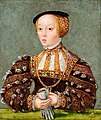
Elizabeth of Austria, Queen of Poland (1526–1545)

King Philip II (1527-1598)
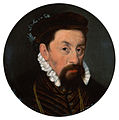
Emperor Maximilian II (1527-1576)

Maria of Austria, Holy Roman Empress (1528-1603)

Anna of Austria, Duchess of Bavaria (1528-1590)

Ferdinand II, ruler of Tirol and Further Austria (1529-1595)
Maria of Austria, Duchess of Jülich-Cleves-Berg (1531-1581)

Magdalena of Austria, abbess of Hall in Tirol (1532-1590)

Catherine of Austria, Queen of Poland (1533-1572)

Eleanor of Austria, Duchess of Mantua (1534-1594)

Joanna of Austria, Princess of Portugal (1535-1573)
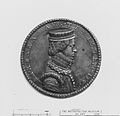
Barbara of Austria, Duchess of Ferrara (1539-1572)
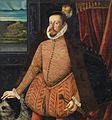
Charles II, ruler of Inner Austria (1540-1590)

Carlos, Prince of Asturias (1545-1568)

Joanna of Austria, Grand Duchess of Tuscany (1547-1578)

John of Austria (1547-1578)

Anna of Austria, Queen of Spain (1549-1580)

Emperor Rudolf II (1552-1612)

Ernest of Austria, ruler of Inner Austria, governor of the Spanish Netherlands (1553-1595)

Elisabeth of Austria, Queen of France (1554-1592)

Emperor Matthias (1557-1619)

Cardinal Andrew of Austria (1558-1600)

Maximilian III, ruler of Further Austria (1558-1618)

Albert (VII), ruler of the Spanish Netherlands (1559-1621)

Charles of Austria, Margrave of Burgau (1560-1618)
Isabella Clara Eugenia, ruler of the Spanish Netherlands (1566-1633)

Margaret of Austria, poor Clare (1567–1633)

Catalina Micaela of Spain, Duchess of Savoy (1567-1597)

Anne of Austria, Queen of Poland (1573-1598)

Maria Christina, Princess of Transylvania (1574-1621)

King Philip III (1578-1621)

Emperor Ferdinand II (1578-1637)

Eleanor of Austria, nun in Hall in Tirol (1582–1620)
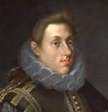
Maximilian Ernest of Austria, Coadjutor of the Teutonic Order (1583-1616)

Maria of Austria, nun in Innsbrück (1584–1649)

Margaret of Austria, Queen of Spain (1584-1611)

Anna of Tyrol, Holy Roman Empress (1585-1618)

Leopold V, ruler of Tirol and Further Austria (1586-1632)

Constance of Austria, Queen of Poland (1588-1631)

Maria Maddalena of Austria, Grand Duchess of Tuscany (1589-1631)

Charles of Austria, Bishop of Breslau (1590-1624)

Anne of Austria, Queen of France (1601-1666)
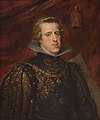
King Philip IV (1605-1665)

Maria Anna of Spain, Holy Roman Empress (1606-1646)
Infante Carlos of Spain (1607–1632)

Emperor Ferdinand III (1608-1657)

Cardinal-Infante Ferdinand of Austria (1609 or 1610-1641)

Maria Anna, Electress of Bavaria (1610-1665)

Cecilia Renata of Austria, Queen of Poland (1611-1644)

Leopold Wilhelm of Austria (1614-1662)

Ferdinand Charles, ruler of Further Austria including Tirol (1628-1662)

John Joseph of Austria (1629-1679)

Isabella Clara of Austria, Duchess of Mantua, Montferrat, Nevers, Mayenne and Rethel (1629-1685)

Sigismund Francis, ruler of Further Austria including Tirol (1630-1665)

Maria Leopoldine of Austria, Holy Roman Empress (1632-1649)

Ferdinand IV, King of the Romans (1633-1654)

Mariana of Austria, Queen of Spain (1634-1696)

Maria Theresa, Queen of France (1638-1683)

Emperor Leopold I (1640-1705)

Margaret Theresa of Spain, Holy Roman Empress (1651-1673)

Eleonore of Austria, Queen of Poland (1653-1697)

Claudia Felicitas of Austria, Holy Roman Empress (1653-1676)

Maria Anna Josepha of Austria, Electress of the Palatinate (1654-1689)

King Charles II (1661-1700)
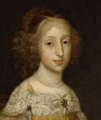
Maria Antonia of Austria, Electress of Bavaria (1669-1692)

Emperor Joseph I (1678-1711)

Maria Elisabeth of Austria, governor of the Austrian Netherlands (1680-1741)

Maria Anna of Austria, Queen of Portugal (1683-1754)

Emperor Charles VI (1685-1740)

Maria Magdalena of Austria (1689–1743)

Maria Josepha of Austria, Queen of Poland (1699-1757)

Maria Amalia, Holy Roman Empress (1701-1756)

Maria Theresa of Austria, Holy Roman Empress (1717-1780)

Maria Anna of Austria, governor of the Austrian Netherlands (1718-1744)
Habsburg-Lorraine[]

Maria Anna (1738-1789)

Emperor Joseph II (1741-1790)

Maria Christina, Duchess of Teschen (1742-1798)

Maria Elisabeth, abbess of Innsbrück (1743-1808)

Maria Amalia, Duchess of Parma (1746-1804)

Emperor Leopold II (1747-1792)

Maria Carolina of Austria, Queen of Naples and Sicily (1752-1814)

Marie Antoinette, Queen of France (1755-1793)

Maximilian Francis of Austria, Elector of Cologne (1756-1801)

Maria Theresa of Austria, Queen of Saxony (1767–1827)

Emperor Francis II and I (1768-1835)

Maria Anna of Austria, Princess-Abbess of the Theresian Institution in Prague (1770-1809)

Archduke Charles, Duke of Teschen (1771-1847)

Alexander Leopold of Austria, Palatine of Hungary (1772-1795)

Joseph of Austria, Palatine of Hungary (1776-1847)

Maria Clementina of Austria, Princess of Naples (1777-1801)

Anton Victor of Austria, Elector of Cologne (1779-1835)

John of Austria, Regent of the German Empire (1782-1859)

Rainer Joseph of Austria, Viceroy of Lombardy-Venetia (1783-1853)

Archduke Louis of Austria (1784-1864)
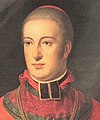
Rudolf of Austria, Cardinal-Archbishop of Olmütz (1788-1831)

Marie Louise, Empress of the French, Duchess of Parma (1791-1847)

Emperor Ferdinand I (1793-1875)

Maria Leopoldina of Austria, Queen of Portugal, Empress of Brazil (1797-1826)

Clementina of Austria, Princess of Salerno (1798-1881)

Leopold Ludwig of Austria, Viceadmiral in the Austro-Hungarian Navy (1800-1856)

Marie Caroline of Austria, Crown Princess of Saxony (1801-1832)
Archduke Franz Karl of Austria (1802-1878)

Archduchess Marie Anne of Austria (1804-1858)
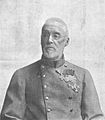
Albrecht, Duke of Teschen (1817-1895)

Hermine of Austria, Princess-Abbess of the Theresian Institution (1817-1842)

Stephen of Austria, Palatine of Hungary (1817-1867)

Lieutenant Field Marshal Karl Ferdinand of Austria (1818-1874)

Adelaide of Austria, Queen of Sardinia (1822-1855)
Ernest of Austria, General of the Cavalry (1824–1899)

Maria Karoline of Austria, Princess-Abbess of the Theresian Institution (1825-1915)

Rainer Ferdinand, Minister-President of Austria (1827-1913)

Wilhelm Franz of Austria, Grand Master of the Teutonic Knights (1827-1894)
Lieutenant Field Marshal Heinrich Anton of Austria (1828-1891)

Emperor Franz Joseph I (1830-1916)

Archduchess Elisabeth Franziska of Austria (1831-1903)

Maximilian I of Mexico (1832-1867)

Joseph Karl of Austria, Palatine of Hungary (1833-1905)

Archduke Karl Ludwig of Austria (1833-1896)

Marie Henriette of Austria, Queen of the Belgians (1836-1902)

Franz, Count of Meran (1839-1891)

Archduke Ludwig Viktor of Austria (1842-1919)

Friedrich, Duke of Teschen (1856-1936)

Maria Christina of Austria, Queen of Spain (1858-1929)

Charles Stephen of Austria, Grand Admiral in the Austro-Hungarian Navy (1860-1933)

Eugen of Austria, Grand Master of the Teutonic Knights (1863-1954)

Gisela of Austria, Princess of Bavaria (1856-1932)

Rudolf, Crown Prince of Austria (1858-1889)

Archduke Franz Ferdinand of Austria (1863-1914)
Archduke Otto of Austria (1865–1906)

Maria Dorothea of Austria, Duchess of Orléans (1867-1932)

Archduchess Marie Valerie of Austria (1868-1924)

Archduke Ferdinand Karl of Austria (1868-1915)
Margarete Sophie of Austria, Duchess of Württemberg (1870-1902)

Margarethe Klementine of Austria, Princess of Thurn and Taxis (1870-1955)

Field Marshal Joseph August of Austria (1872-1962)

Maria Annunciata of Austria, Princess-Abbess of the Theresian Institution (1876-1961)

Elisabeth Amalie of Austria, Princess of Liechtenstein (1878-1960)

Maria Anna of Austria, Princess of Bourbon-Parma (born 1882)

Maria Henrietta of Austria, Princess of Hohenlohe-Schillingsfürst (1883-1956)

"Red Archduchess" Elisabeth Marie of Austria (1883-1963)

Archduchess Eleonora of Austria (1886-1974)

Emperor Charles I (1887-1922)

Renata of Austria, Princess Radziwiłł (1888-1935)

Isabella of Austria, Princess of Bavaria (1888-1973)

Archduke Karl Albrecht of Austria (1888-1951)

Mechthildis of Austria, Princess Czartoryski (1891-1966)

Otto von Habsburg (1912-2011)
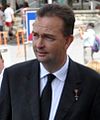
Karl von Habsburg (1961-)
Habsburg-Este (first line)[]

Ferdinand Karl, titular Duke of Modena and Reggio (1754-1806)

Maria Theresa of Austria-Este, Queen of Sardinia (1773-1832)

Maria Leopoldine of Austria-Este, Electress of Bavaria (1776-1848)

Francis IV, Duke of Modena, Reggio and Mirandola (1779-1846)

Ferdinand Karl Joseph of Austria-Este, Governor of Galicia 1781-1850)

Maximilian of Austria-Este, grand master of the Teutonic Knights (1782-1863)

Karl Ambrosius of Austria-Este, Archbishop of Esztergom (1785-1809)

Maria Ludovika of Austria-Este, Empress of Austria (1787-1816)

Francis V, Duke of Modena, Reggio and Guastalla (1819-1875)

Lieutenant Field Marshal Ferdinand Karl Viktor of Austria-Este (1821-1849)

Maria Theresa of Austria-Este, Queen of Bavaria (1849–1919)
Habsburg-Tuscany[]

Ferdinand III, Grand Duke of Tuscany (1769-1824)

Leopold II, Grand Duke of Tuscany (1797-1870)

Maria Luisa of Austria, Princess of Tuscany (1798–1857)

Maria Theresa of Austria, Queen of Sardinia (1801–1855)

Auguste Ferdinande of Austria, Princess of Bavaria (1825-1864)

Maria Isabella of Austria, Countess of Trapani (1834-1901)

Ferdinand IV, Grand Duke of Tuscany (1835-1908)

Archduke Karl Salvator of Austria (1839-1892)

Maria Luisa of Austria, Princess of Tuscany (1845-1917)

Archduke Ludwig Salvator of Austria (1847-1915)

Archduke Johann Salvator of Austria (1852-1911)

Maria Antonietta of Austria, Princess of Tuscany (1858–1883)

Archduchess Maria Theresa of Austria (1862–1933)

Archduke Leopold Salvator of Austria (1863-1931)

Franz Salvator of Austria, Prince of Tuscany (1866-1939)

Archduke Leopold Ferdinand of Austria (1868-1935)

Karoline Marie of Austria, Princess of Tuscany (1869-1945)

Louise of Austria, Crown Princess of Saxony (1870-1947)

Generaloberst Joseph Ferdinand of Austria (1872-1942)

Archduke Peter Ferdinand of Austria (1874-1948)

Anton of Austria, pretender to the Spanish throne (1901-1987)

Gottfried of Austria, titular Grand Duke of Tuscany (1902-1984)

Dominic von Habsburg, pretender to the Spanish throne (1937-) (center)
Habsburg-Este (later line)[]

Robert, Archduke of Austria-Este (1915-1996)
Heraldry[]
A complete listing of the arms can be found at the Habsburg Armory.
 |
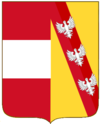 |
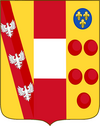 |
 |
|---|---|---|---|
| Arms of Austria impaled with Burgundy (ancient). The most personal arms of Austrian princes from 1477 until 1740 (see here | Personal Arms of Joseph II and Marie Antoinette showing Austria (Habsburg arms) impaled with Lorraine (Lorraine arms). | Tripartite personal arms of Leopold II and Francis II/I showing Austria (Habsburg arms), Lorraine (Lorraine arms) and Tuscany (Medici arms), and used by the House of Austria-Tuscany (see Archduke Sigismund, Grand Duke of Tuscany). | Tripartite personal arms of the "Habsburg" ruling house after 1805 showing the return to prominence of the old Habsburg arms. Used today by most archdukes/archduchesses. |
Arms of Dominion of the Austro-Hungarian Empire[]
The arms of dominion began to take on a life of their own in the 19th century as the idea of the state as independent from the Habsburg dynasty took root. They are the national arms as borne by a sovereign in his capacity as head of state and represent the state as separate from the person of the monarch or his dynasty. That very idea had been, heretofore, foreign to the concept of the Habsburg state. The state had been the personal property of the Habsburg dynasty. Since the states, territories, and nationalities represented were in many cases only united to the Austro-Hungarian Empire by their historic loyalty to the head of the house of Habsburg as hereditary lord, these full ("grand") arms of dominion of Austria-Hungary reflect the complex political infrastructure that was necessarily to accommodate the many different nationalities and groupings within the empire after the Austro-Hungarian Compromise of 1867.


After 1867 the eastern part of the empire, also called Transleithania, was mostly under the domination of the Kingdom of Hungary. The shield integrated the arms of the kingdom of Hungary, with two angels and supporters and the crown of St. Stephen, along with the territories that were subject to it:
The Kingdom of Dalmatia, the Kingdom of Croatia, the Kingdom of Slavonia (conjoined with Croatia as the Kingdom of Croatia-Slavonia - formally known as the Triune Kingdom of Croatia, Slavonia, and Dalmatia, although the claim to Dalmatia was mostly de jure), the Great Principality of Transylvania, the Condominium of Bosnia and Herzegovina (1915–1918), the City of Fiume and its district (modern Rijeka), and in the center, the Kingdom of Hungary.
The western or Austrian part of the empire, Cisleithania, continued using the shield of the Empire in 1815 but with the seals of various member territories located around the central shield. Paradoxically, some of these coats of arms belonged to the territories that were part of the Hungarian part of the empire and shield. This shield, the most frequently used until 1915, was known as the middle shield. There was also the small shield, with just the personal arms of the Habsburgs, as used in 1815.
| I | II | III | IV | V |
|---|---|---|---|---|

|

|

| ||
| Kingdom of Hungary | Kingdom of Galicia and Lodomeria | Archduchy of Austria | Duchy of Salzburg | Duchy of Styria |
| VI | VII | VIII | ||

|

|

|

|

|
| Duchy of Tirol | Duchy of Carinthia and Duchy of Carniola (Marshalled) | Margraviate of Moravia and Duchy of Silesia (Marshalled) | ||
| IX | X | XI | ||

|

| |||
| Great Principality of Transylvania | Kingdom of Illyria | Kingdom of Bohemia | ||
In 1915, in the middle of World War I, Austria-Hungary adopted a heraldic composition uniting the shield that was used in the Hungarian part, also known as the Lands of the Crown of St. Stephen, with a new version of the medium shield of the Austrian part as depicted above in the section on the mainline of the Emperors of Austria.
Before 1915, the arms of the different territories of the Austrian part of the Empire (heraldry was added to some areas not shown in the previous version and to the left to the Hungarian part) appeared together in the shield positioned on the double-headed eagle coat of arms of the Austrian Empire as an inescutcheon. The eagle was inside a shield with a goldfield. The latter shield was supported by two griffins and was topped by the Austrian Imperial Crown (previously these items were included only in the large shield). Then, shown in the center of both arms of dominion, as an inescutcheon to the inescutcheon, is the small shield, i.e. personal arms, of the Habsburgs. All this was surrounded by the collar Order of the Golden Fleece.[52][53]

In the heraldic composition of 1915, the shields of the two foci of the empire, Austria and Hungary, were brought together. The griffin supporter on the left was added for Austria and an angel on the right as a supporter for Hungary. The center featured the personal arms of the Habsburgs (Habsburg, Austria, and Lorraine). This small shield was topped with a royal crown and surrounded by the collar of the Order of the Golden Fleece, below which was the Military Order of Maria Theresa, below which was the collars of the Orders of St. Stephen's and Leopold. At the bottom was the motto that read "AC INDIVISIBILITER INSEPARABILITER" ("indivisible and inseparable"). Other simplified versions did not have the supports depicted, and the simple shields of Austria and Hungary. These were the arms of the Empire of Austria with an inescutcheon of Austria, and the Arms of Hungary (with chequer of Croatia at the tip).

| Austrian Lands | |||
| Shield | Partition | Territory | |
|---|---|---|---|
 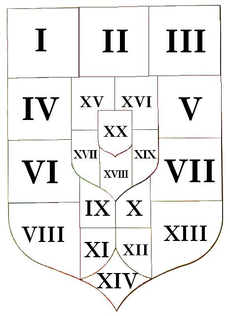 |
I |
Kingdom of Galicia and Lodomeria Kingdom of Bohemia Kingdom of Dalmatia Duchy of Upper and Lower Silesia Duchy of Salzburg Margraviate of Moravia County of Tirol Duchy of Bukovina Province of Vorarlberg Margraviate of Istria County of Gorizia (part of the Princely County of Gorizia and Gradisca) County of Gradisca (also part of the Princely County of Gorizia and Gradisca) Province of Bosnia and Herzegovina (Conjoined) Imperial Free City of Trieste Archduchy of Lower Austria Archduchy of Upper Austria Duchy of Styria Duchy of Carniola Duchy of Carinthia Archduchy of Austria |
|
| Territories of the crown of St. Stephen | ||
| Shield | Partition | Territory |
|---|---|---|
 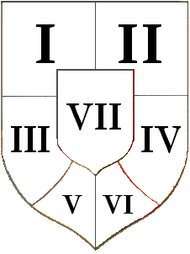 |
I II III IV V VI VII |
Kingdom of Dalmatia (Legally Hungarian) Kingdom of Croatia Kingdom of Slavonia Grand Principality of Transylvania Province of Bosnia and Herzegovina (Conjoined) City of Fiume and its district Kingdom of Hungary |
| Personal Shield of the Dynasty | ||
| Shield | Partition | Significance |
|---|---|---|
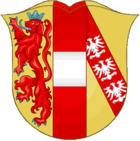 |
I II III |
Count of Habsburg Archduke of Austria Duke of Lorraine |
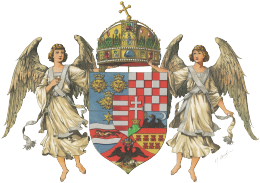
|

|
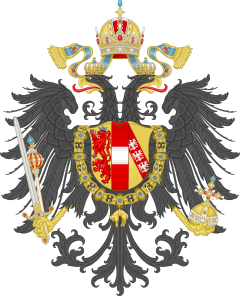
|
| Arms of the Lands of the Crown of Saint Stephen (1867–1915) | Arms of the Lands of the Crown of Saint Stephen (1915–1918) | Small Arms of Austria (Cisleithania) (1805–1918) |
|---|---|---|

|

|

|
| Simple Arms of Cisleithania (1915–1918) | Personal Arms of the Emperor Franz Josef (1848–1916) | Simple Arms of the Austrian and Hungarian parts of the empire (1915–1918) |
Family trees[]
Ancestors of the Habsburgs[]
Fragmentary references (see below) cite the Habsburgs as descendants of the early Germanic Etichonider, probably of Frankish, Burgundian or Visigothic origin, who ruled the Duchy of Alsace in the Early Middle Ages (7th–10th centuries). The dynasty is named for Eticho (also known as Aldarich) who ruled from 662 to 690.
| Eticho I (635–690) r. 662–690 Count of Alsace | |||||||||||||||||||||||||||||||||
| Eticho II (700–723) r. 722–723 Count of Nordgau | |||||||||||||||||||||||||||||||||
| Alberic I d. 747 r. 723–747 Count of Nordgau | |||||||||||||||||||||||||||||||||
| Eberhard II d. 777 r. 765–777 Count of Nordgau | |||||||||||||||||||||||||||||||||
| Eberhard III of Dillingen d. 874 r. 817–864 Count of Nordgau | |||||||||||||||||||||||||||||||||
| ? | |||||||||||||||||||||||||||||||||
| Hugo III d. 940 r. 910–940 Count of Nordgau | |||||||||||||||||||||||||||||||||
| Guntram the Rich[46] Count in Breisgau c. 920–973 member of Etichonider family | Eberhard IV d. 972/3 | ||||||||||||||||||||||||||||||||
Early Habsburgs[]
Family tree of the ancestors of the Habsburg family, largely before becoming Holy Roman Emperors and (Arch)Dukes of Austria. This family tree only includes male scions of the House of Habsburg from 920 to 1308.[54] Otto II was probably the first to take the Habsburg Castle name as his own, adding "von Habsburg" to his title and creating the House of Habsburg.[48] See below for more references.
| Guntram the Rich[46] Count in Breisgau c. 920–973 member of Etichonider family | |||||||||||||||||||||||||||||||||||
| Lanzelin of Klettgau and Altenburg | |||||||||||||||||||||||||||||||||||
| Werner I Bishop of Strasbourg c. 978/980–1028 | Radbot of Klettgau built Habsburg Castle Count of Habsburg c. 985–1045 | ||||||||||||||||||||||||||||||||||
| Werner I the Pious[55] Count of Habsburg c. 1025/1030–1096 | |||||||||||||||||||||||||||||||||||
| Otto II Count of Habsburg 1096–1111 | |||||||||||||||||||||||||||||||||||
| Werner II Count of Habsburg 1111–1167 | |||||||||||||||||||||||||||||||||||
| Otto III Bishop of Constance 1166–1174 | Albert III Count of Habsburg 1167–1199 | ||||||||||||||||||||||||||||||||||
| Rudolf II Count of Habsburg 1199–1232 | |||||||||||||||||||||||||||||||||||
| Albert IV Count of Habsburg 1232–1239 | Rudolf III Count of Habsburg 1232 1232–1249 | ||||||||||||||||||||||||||||||||||
| Rudolf IV (I) Count of Habsburg 1240–1291 King of Germany 1273–1291 Duke of Austria and Styria 1278–1282 Duke of Carinthia 1276–1286  | Eberhard I Count of Kiburg 1249–1284 | Gottfried I Count of Laufenburg 1249–1271 | |||||||||||||||||||||||||||||||||
| Albert I Duke of Austria, Styria and Carniola 1282–1308 Holy Roman Emperor 1298–1308  | Rudolf II Duke of Swabia 1282–1290 Duke of Austria 1282–1283 | Kiburg Line 1284–1414 | Laufenburg Line 1271–1408 | ||||||||||||||||||||||||||||||||
| John the Parricide (murdered his uncle Albert I) | |||||||||||||||||||||||||||||||||||
| House of Austria see below | |||||||||||||||||||||||||||||||||||
Middle Habsburgs[]
| hideMale scions of the direct House of Habsburg who survived to adulthood[56] | |||||||||||||||||||||||||||||||||||||||||||||||||||||||||||||||||||||||||||||||||||||||||||||||||||||||||||||||||||||||||||||||||||||||||||||||||||||||||||||||||||||||||||||||||||||||||||||||||||||||||||||||||||||||||||||||||||||||||||||||||||||||||||||||||||||||||||||||||||||||||||||||||||||||||||||||||||||||||||||||||||||||||||||||||||||||||||||||||||||||||||||||||||||||||||||||||||||||||||||||||||||||||||||||||||||||||||||||||||||||||||||||||||||||||||||||||||||||||||||||||||||||||||||||||||||||||||||||||||||||||||||||||||||||||||||||||||||||||||||||||||||||||||||||||||||||||||||||||||||||||||||||||||||||||||||||||||||||||||||||||||||||||||||||||||||||||||||||||||||||||||||||||||||||||||||||||||||||||||||||||||||||||||||||||||||||||||||||||||||||||||||||||||||||||||||||||||||||||||||||||||||||||||||||||||||||||||||||||||||||||||||||||||||||||||||||||||||||||||||||||||||||||||||||||||||||||||||||||||||||||||||||||||||||||||||||||||||||||||||||||||||||||||||||||||||||||||||||||||||||
|---|---|---|---|---|---|---|---|---|---|---|---|---|---|---|---|---|---|---|---|---|---|---|---|---|---|---|---|---|---|---|---|---|---|---|---|---|---|---|---|---|---|---|---|---|---|---|---|---|---|---|---|---|---|---|---|---|---|---|---|---|---|---|---|---|---|---|---|---|---|---|---|---|---|---|---|---|---|---|---|---|---|---|---|---|---|---|---|---|---|---|---|---|---|---|---|---|---|---|---|---|---|---|---|---|---|---|---|---|---|---|---|---|---|---|---|---|---|---|---|---|---|---|---|---|---|---|---|---|---|---|---|---|---|---|---|---|---|---|---|---|---|---|---|---|---|---|---|---|---|---|---|---|---|---|---|---|---|---|---|---|---|---|---|---|---|---|---|---|---|---|---|---|---|---|---|---|---|---|---|---|---|---|---|---|---|---|---|---|---|---|---|---|---|---|---|---|---|---|---|---|---|---|---|---|---|---|---|---|---|---|---|---|---|---|---|---|---|---|---|---|---|---|---|---|---|---|---|---|---|---|---|---|---|---|---|---|---|---|---|---|---|---|---|---|---|---|---|---|---|---|---|---|---|---|---|---|---|---|---|---|---|---|---|---|---|---|---|---|---|---|---|---|---|---|---|---|---|---|---|---|---|---|---|---|---|---|---|---|---|---|---|---|---|---|---|---|---|---|---|---|---|---|---|---|---|---|---|---|---|---|---|---|---|---|---|---|---|---|---|---|---|---|---|---|---|---|---|---|---|---|---|---|---|---|---|---|---|---|---|---|---|---|---|---|---|---|---|---|---|---|---|---|---|---|---|---|---|---|---|---|---|---|---|---|---|---|---|---|---|---|---|---|---|---|---|---|---|---|---|---|---|---|---|---|---|---|---|---|---|---|---|---|---|---|---|---|---|---|---|---|---|---|---|---|---|---|---|---|---|---|---|---|---|---|---|---|---|---|---|---|---|---|---|---|---|---|---|---|---|---|---|---|---|---|---|---|---|---|---|---|---|---|---|---|---|---|---|---|---|---|---|---|---|---|---|---|---|---|---|---|---|---|---|---|---|---|---|---|---|---|---|---|---|---|---|---|---|---|---|---|---|---|---|---|---|---|---|---|---|---|---|---|---|---|---|---|---|---|---|---|---|---|---|---|---|---|---|---|---|---|---|---|---|---|---|---|---|---|---|---|---|---|---|---|---|---|---|---|---|---|---|---|---|---|---|---|---|---|---|---|---|---|---|---|---|---|---|---|---|---|---|---|---|---|---|---|---|---|---|---|---|---|---|---|---|---|---|---|---|---|---|---|---|---|---|---|---|---|---|---|---|---|---|---|---|---|---|---|---|---|---|---|---|---|---|---|---|---|---|---|---|---|---|---|---|---|---|---|---|---|---|---|---|---|---|---|---|---|---|---|---|---|---|---|---|---|---|---|---|---|---|---|---|---|---|---|---|---|---|---|---|---|---|---|---|---|---|---|---|---|---|---|---|---|---|---|---|---|---|---|---|---|---|---|---|---|---|---|---|---|---|---|---|---|---|---|---|---|---|---|---|---|---|---|---|---|---|---|---|---|---|---|---|---|---|---|---|---|---|---|---|---|---|---|---|---|---|---|---|---|---|---|---|---|---|---|---|---|---|---|---|---|---|---|---|---|---|---|---|---|---|---|---|---|---|---|---|---|---|---|---|---|---|---|---|---|---|---|---|---|---|---|---|---|---|---|---|---|---|---|---|---|---|---|---|---|---|---|---|---|---|---|---|---|---|---|---|---|---|---|---|---|---|---|---|---|---|---|---|---|---|---|---|---|---|---|---|---|---|---|---|---|---|---|---|---|---|---|---|---|---|---|---|---|---|---|---|---|---|---|---|---|---|---|---|---|---|---|---|---|---|---|---|---|---|---|---|---|---|---|---|---|---|---|---|---|---|---|---|---|---|---|---|---|---|---|---|---|---|---|---|---|---|---|---|---|---|---|---|---|---|---|---|---|---|---|---|---|---|---|---|---|---|---|---|---|---|---|---|---|---|---|---|---|---|---|---|---|---|---|---|---|---|---|---|---|---|---|---|---|---|---|---|---|---|---|---|---|---|---|---|---|---|---|---|---|---|---|---|---|---|---|---|---|---|---|---|---|---|---|---|---|---|---|---|---|---|---|---|---|---|---|---|---|---|---|---|---|---|---|---|---|---|---|---|---|---|---|---|---|---|---|---|---|---|---|---|---|---|---|---|---|---|---|---|---|---|---|---|---|---|---|---|---|---|---|---|---|---|
| |||||||||||||||||||||||||||||||||||||||||||||||||||||||||||||||||||||||||||||||||||||||||||||||||||||||||||||||||||||||||||||||||||||||||||||||||||||||||||||||||||||||||||||||||||||||||||||||||||||||||||||||||||||||||||||||||||||||||||||||||||||||||||||||||||||||||||||||||||||||||||||||||||||||||||||||||||||||||||||||||||||||||||||||||||||||||||||||||||||||||||||||||||||||||||||||||||||||||||||||||||||||||||||||||||||||||||||||||||||||||||||||||||||||||||||||||||||||||||||||||||||||||||||||||||||||||||||||||||||||||||||||||||||||||||||||||||||||||||||||||||||||||||||||||||||||||||||||||||||||||||||||||||||||||||||||||||||||||||||||||||||||||||||||||||||||||||||||||||||||||||||||||||||||||||||||||||||||||||||||||||||||||||||||||||||||||||||||||||||||||||||||||||||||||||||||||||||||||||||||||||||||||||||||||||||||||||||||||||||||||||||||||||||||||||||||||||||||||||||||||||||||||||||||||||||||||||||||||||||||||||||||||||||||||||||||||||||||||||||||||||||||||||||||||||||||||||||||||||||||
| hide | ||||||||||||||||||||||||||||||||||||||||||||||||||||||||||||||||||||||||||||||||||||||||||||||||||||||||||||||||||||||||||||||||||||||||||||||||||||||||||||||||||||||||||||||||||||||||||||||||||||||||||||||||||||||||||||||||||||||||||||||||||||||||||||||||||||||||||||||||||||||||||||||||||||||||||||||||||||||||||||||||||||||||||||||||||||||||||||||||||||||||||||||||||||||||||||||||||||||||||||||||||||||||||||||||||||||||||||||||||||||||||||||||||||||||||||||||||||||||||||||||||||||||||||||||||||||||||||||||||||||||||||||||||||||||||||||||||||||||||||||||||||||||||||||||||||||||||||||||||||||||||||||||||||||||||||||||||||||||||||||||||||||||||||||||||||||||||||||||||||||||||||||||||||||||||||||||||||||||||||||||||||||||||||||||||||||||||||||||||||||||||||||||||||||||||||||||||||||||||||||||||||||||||||||||||||||||||||||||||||||||||||||||||||||||||
|---|---|---|---|---|---|---|---|---|---|---|---|---|---|---|---|---|---|---|---|---|---|---|---|---|---|---|---|---|---|---|---|---|---|---|---|---|---|---|---|---|---|---|---|---|---|---|---|---|---|---|---|---|---|---|---|---|---|---|---|---|---|---|---|---|---|---|---|---|---|---|---|---|---|---|---|---|---|---|---|---|---|---|---|---|---|---|---|---|---|---|---|---|---|---|---|---|---|---|---|---|---|---|---|---|---|---|---|---|---|---|---|---|---|---|---|---|---|---|---|---|---|---|---|---|---|---|---|---|---|---|---|---|---|---|---|---|---|---|---|---|---|---|---|---|---|---|---|---|---|---|---|---|---|---|---|---|---|---|---|---|---|---|---|---|---|---|---|---|---|---|---|---|---|---|---|---|---|---|---|---|---|---|---|---|---|---|---|---|---|---|---|---|---|---|---|---|---|---|---|---|---|---|---|---|---|---|---|---|---|---|---|---|---|---|---|---|---|---|---|---|---|---|---|---|---|---|---|---|---|---|---|---|---|---|---|---|---|---|---|---|---|---|---|---|---|---|---|---|---|---|---|---|---|---|---|---|---|---|---|---|---|---|---|---|---|---|---|---|---|---|---|---|---|---|---|---|---|---|---|---|---|---|---|---|---|---|---|---|---|---|---|---|---|---|---|---|---|---|---|---|---|---|---|---|---|---|---|---|---|---|---|---|---|---|---|---|---|---|---|---|---|---|---|---|---|---|---|---|---|---|---|---|---|---|---|---|---|---|---|---|---|---|---|---|---|---|---|---|---|---|---|---|---|---|---|---|---|---|---|---|---|---|---|---|---|---|---|---|---|---|---|---|---|---|---|---|---|---|---|---|---|---|---|---|---|---|---|---|---|---|---|---|---|---|---|---|---|---|---|---|---|---|---|---|---|---|---|---|---|---|---|---|---|---|---|---|---|---|---|---|---|---|---|---|---|---|---|---|---|---|---|---|---|---|---|---|---|---|---|---|---|---|---|---|---|---|---|---|---|---|---|---|---|---|---|---|---|---|---|---|---|---|---|---|---|---|---|---|---|---|---|---|---|---|---|---|---|---|---|---|---|---|---|---|---|---|---|---|---|---|---|---|---|---|---|---|---|---|---|---|---|---|---|---|---|---|---|---|---|---|---|---|---|---|---|---|---|---|---|---|---|---|---|---|---|---|---|---|---|---|---|---|---|---|---|---|---|---|---|---|---|---|---|---|---|---|---|---|---|---|---|---|---|---|---|---|---|---|---|---|---|---|---|---|---|---|---|---|---|---|---|---|---|---|---|---|---|---|---|---|---|---|---|---|---|---|---|---|---|---|---|---|---|---|---|---|---|---|---|---|---|---|---|---|---|---|---|---|---|---|---|---|---|---|---|---|---|---|---|---|---|---|---|---|---|---|---|---|---|---|---|---|---|---|---|---|---|---|---|---|---|---|---|---|---|---|---|---|---|---|---|---|---|---|---|---|---|---|---|---|---|---|---|---|---|---|---|---|---|---|---|---|---|---|---|---|---|---|---|---|---|---|---|---|---|---|---|---|---|---|---|---|---|---|---|---|---|---|---|---|---|---|---|---|---|---|---|---|---|---|---|---|---|---|---|---|---|---|---|---|---|---|---|---|---|---|---|---|---|---|---|---|---|---|---|---|---|---|---|---|---|---|---|---|---|---|---|---|---|---|---|---|---|---|---|---|---|---|---|---|---|---|---|---|---|---|---|---|---|---|---|---|---|---|---|---|---|---|---|---|---|---|---|---|---|---|---|---|---|---|---|---|---|---|---|---|---|---|---|---|---|---|---|---|---|---|---|---|---|---|---|---|---|---|---|---|---|---|---|---|---|---|---|---|---|---|---|---|---|---|---|---|---|---|---|---|---|---|---|---|---|---|---|---|---|---|---|---|---|---|---|---|---|---|---|---|---|---|
| ||||||||||||||||||||||||||||||||||||||||||||||||||||||||||||||||||||||||||||||||||||||||||||||||||||||||||||||||||||||||||||||||||||||||||||||||||||||||||||||||||||||||||||||||||||||||||||||||||||||||||||||||||||||||||||||||||||||||||||||||||||||||||||||||||||||||||||||||||||||||||||||||||||||||||||||||||||||||||||||||||||||||||||||||||||||||||||||||||||||||||||||||||||||||||||||||||||||||||||||||||||||||||||||||||||||||||||||||||||||||||||||||||||||||||||||||||||||||||||||||||||||||||||||||||||||||||||||||||||||||||||||||||||||||||||||||||||||||||||||||||||||||||||||||||||||||||||||||||||||||||||||||||||||||||||||||||||||||||||||||||||||||||||||||||||||||||||||||||||||||||||||||||||||||||||||||||||||||||||||||||||||||||||||||||||||||||||||||||||||||||||||||||||||||||||||||||||||||||||||||||||||||||||||||||||||||||||||||||||||||||||||||||||||||||
Notes:
| ||||||||||||||||||||||||||||||||||||||||||||||||||||||||||||||||||||||||||||||||||||||||||||||||||||||||||||||||||||||||||||||||||||||||||||||||||||||||||||||||||||||||||||||||||||||||||||||||||||||||||||||||||||||||||||||||||||||||||||||||||||||||||||||||||||||||||||||||||||||||||||||||||||||||||||||||||||||||||||||||||||||||||||||||||||||||||||||||||||||||||||||||||||||||||||||||||||||||||||||||||||||||||||||||||||||||||||||||||||||||||||||||||||||||||||||||||||||||||||||||||||||||||||||||||||||||||||||||||||||||||||||||||||||||||||||||||||||||||||||||||||||||||||||||||||||||||||||||||||||||||||||||||||||||||||||||||||||||||||||||||||||||||||||||||||||||||||||||||||||||||||||||||||||||||||||||||||||||||||||||||||||||||||||||||||||||||||||||||||||||||||||||||||||||||||||||||||||||||||||||||||||||||||||||||||||||||||||||||||||||||||||||||||||||||
Later Habsburgs[]
Similarly, this family tree only includes male scions of the House of Habsburg-Lorraine who survived to adulthood:

See also[]
- A.E.I.O.U.
- Habsburg Monarchy
- Habsburg Spain
- Royal intermarriage
- House of France
- House of Savoy
Notes[]
- ^ Jump up to: a b c d e Jure uxoris.
- ^ Jump up to: a b Queen consort.
- ^ Jump up to: a b Titular claim rather than de facto.
- ^ Jump up to: a b Contested.
- ^ Title given to Philip II by his father, Charles V, prior to his marriage with Mary of England. This was ensure that Philip would not be outranked by his wife.
- ^ Through Archduke Lorenz of Austria-Este.
References[]
- ^ Kiva, Cross, and Crown: The Pescos Indians and New Mexico, p. 251.
- ^ Letters of Don Diego de Vargas to His Family from New Spain and New Mexico, p. 56.
- ^ "The House of Austria – the Habsburgs and the Empire".
- ^ "Habsburger-Gedenkjahr im Aargau", Neue Zürcher Zeitung, (page 17) 23 May 2008.
- ^ "art-tv.ch". Archived from the original on September 21, 2008.
- ^ "Kanton Aargau" (in German). Archived from the original on December 23, 2008.
- ^ Jean Berenger, C.A. Simpson (2014). A History of the Habsburg Empire 1273-1700. Routledge. pp. 12–13. ISBN 978-1317895701.
- ^ Martyn Rady (2020). "1, Castle Habsburg and the 'fortinbras Effect'". The Habsburgs: The Rise and Fall of a World Power. Penguin UK. ISBN 978-0141987194.
- ^ Jump up to: a b c d e f g Heinz-Dieter Heimann: Die Habsburger. Dynastie und Kaiserreiche. ISBN 3-406-44754-6.
- ^ Naumann 1855, pp. 11 passim.
- ^ Kos 1985, p. 260.
- ^ France Dolinar & al, Slovenski zgodovinski atlas (Ljubljana: Nova revija, 2011), p. 72.
- ^ Hugh Agnew. The Czechs and the Lands of the Bohemian Crown. Studies of Nationalities. Stanford: Hoover Institution Press, 2004. p. 29.
- ^ Genealogisches Handbuch des Adels, Furstliche Hauser Band XIV. Limburg ad der Lahn, Germany: C. A. Starke Verlag. 1991. pp. 91–93. ISBN 978-3-7980-0700-0.
- ^ Jump up to: a b Erbe 2000, p. ?.
- ^ Callaghan 2019, pp. 112–114.
- ^ Wilson, Peter H. (October 27, 2010). The Thirty Years War: A Sourcebook. Macmillan International Higher Education. ISBN 9781137069771 – via Google Books.
- ^ The Hungary was partly under Habsburg rule from 1526. For 150 years most of the country was occupied by the Ottoman Turks but these territories were re-conquered in 1683–1699.
- ^ Jump up to: a b FC Ceballos; G Alvarez (2013). "Royal dynasties as human inbreeding laboratories: the Habsburgs". Heredity. 111 (2): 114–121. doi:10.1038/hdy.2013.25. PMC 3716267. PMID 23572123.
- ^ Vilas, Román; Ceballos, Francisco C.; Al-Soufi, Laila; González-García, Raúl; Moreno, Carlos; Moreno, Manuel; Villanueva, Laura; Ruiz, Luis; Mateos, Jesús; González, David; Ruiz, Jennifer (2019-12-02). "Is the "Habsburg jaw" related to inbreeding?". Annals of Human Biology. 46 (7–8): 553–561. doi:10.1080/03014460.2019.1687752. ISSN 0301-4460. PMID 31786955. S2CID 208536371.
- ^ Deon Hollway, "The Habsburg Chin" History Magazine (Dec 2014/Jan 2015) 16#2 pp. 6-7.
- ^ Bittles, et al 2002, pp. 111-130.
- ^ Alvarez, Gonzalo; Ceballos, Francisco C.; Quinteiro, Celsa (April 15, 2009). Bauchet, Marc (ed.). "The Role of Inbreeding in the Extinction of a European Royal Dynasty". PLOS ONE. 4 (4): e5174. Bibcode:2009PLoSO...4.5174A. doi:10.1371/journal.pone.0005174. PMC 2664480. PMID 19367331.
- ^ Maria Theresa was originally engaged to Léopold Clément of Lorraine, older brother of Francis Stephan.
- ^ Jump up to: a b Chisholm, Hugh, ed. (1911). . Encyclopædia Britannica. 3 (11th ed.). Cambridge University Press. pp. 2–39.
- ^ Microsoft Encarta: The height of the dual monarchy.
- ^ Timothy Snyder "The Red Prince: The Secret Lives of a Habsburg Archduke" (2008); James Longo "Hitler and the Habsburgs: The Fuhrer's Vendetta Against the Austrian Royals" (2018); Bob Carruthers "Hitler's Violent Youth: How Trench Warfare and Street Fighting Moulded Hitler" (2015).
- ^ On Habsburg and the diversity: Pieter M. Judson "The Habsburg Empire. A New History" (Harvard 2016); Christopher Clark "The Sleepwalkers" (New York 2012).
- ^ Wolfgang Mueller "Die sowjetische Besatzung in Österreich 1945-1955 und ihre politische Mission" (German - "The Soviet occupation in Austria 1945-1955 and its political mission"), 2005, p. 24.
- ^ Otmar Lahodynsky: Paneuropäisches Picknick: Die Generalprobe für den Mauerfall (Pan-European picnic: the dress rehearsal for the fall of the Berlin Wall - German), in: Profil 9 August 2014; Thomas Roser: DDR-Massenflucht: Ein Picknick hebt die Welt aus den Angeln (German - Mass exodus of the GDR: A picnic clears the world) in: Die Presse, 16 August 2018.
- ^ Elisabeth Boeckl-Klamper, Thomas Mang, Wolfgang Neugebauer: Gestapo-Leitstelle Wien 1938–1945. Vienna 2018, ISBN 978-3-902494-83-2, pp. 299–305.
- ^ Jump up to: a b c Jean-Marie Moeglin (2011). L'Empire et le Royaume: Entre indifférence et fascination 1214-1500. Villeneuve-d'Ascq: Presses universitaires du Septentrion.
- ^ "Charles IV – the greatest Czech". Prague.eu.
- ^ "The Golden Bull of the Emperor Charles IV 1356 A.D." Yale Law School - The Avalon Project.
- ^ Madariaga Orbea, Juan (2014). Sociedad y lengua vasca en los siglos XVII y XVIII. Euskaltzaindia. p. 712.
- ^ Charles V, Pierre Chaunu and Michèle Escamilla.
- ^ Cornelius August Wilkens (1897). "VIII. Juan de Valdés". Spanish Protestants in the Sixteenth Century. William Heinemann. p. 66. Retrieved 24 July 2015.
- ^ "Habsburci a jejich jazyková vybavenost". Fórum zájemců o historii. 2010.
- ^ "Could any Habsburg kings of Hungary speak Hungarian?". StackExchange. 2016.
- ^ Martin Mutschlechner. "Franz Joseph: childhood and upbringing". The World of the Habsburgs.
- ^ 1: : Die letzten 120 Jahre der Weltgeschichte, Band 6 (1740-1860), Adolph Krabbe, Stuttgart 1860, S. 211 Online, p. 211, at Google Books
2.: Wolfgang Menzel: Supplementband zu der Geschichte der letzten 40 Jahre (1816-1856). Adolph Krabbe, Stuttgart 1860, S. 153 Online, p. 153, at Google Books
Aus diesem wurde später: „Sire, ich bin ein deutscher Fürst“:
Hermann Struschka: Kaiser Franz Josef I. Georg Szelinski, Wien 1888, S. 22 Online, p. 22, at Google Books
Es Kommt auch in der anglifizierten Schreibung „Sir, ich bin Deutscher Fürst“ vor.
Stenographische Protokolle – Abgeordnetenhaus – Sitzungsprotokolle. Haus der Abgeordneten – 14. Sitzung der XVIII. Session is 16. Juli 1907, S. 1337 alex.onb.ac.at 3: wikiquote:de: Franz Joseph I. von Österreich. - ^ Terezie Foltýnová (2014). "Dr. Otto von Habsburg a jeho proevropský přínos (Dr. Otto von Habsburg and his pro-European contribution)". Masaryk University. Brno.
- ^ The Kingdom of Germany formed the central part of the Holy Roman Empire. Its rulers were styled King of the Romans before their coronation as Emperors.
- ^ Geoffrey Parker. The Grand Strategy of Philip II, (2000)
- ^ Jump up to: a b c Montgomery-Massingberd, Hugh. "Burke’s Royal Families of the World: Volume I Europe & Latin America, 1977, pp. 18, 32. ISBN 0-85011-023-8
- ^ Jump up to: a b c Heinz-Dieter Heimann (2001). Die Habsburger: Dynastie und Kaiserreiche. C. H. Beck. p. 22. ISBN 978-3-406-44754-9.
- ^ Andreas Bönner (2010). Die Religionspolitik der Habsburger Kaiser in der Zeit des Dreißigjährigen Krieges. GRIN Verlag. p. 7. ISBN 978-3-640-50510-4.
- ^ Jump up to: a b "The World of Habsburgs". 2011. Retrieved 2019-04-21.
- ^ Cowans 2003, pp. 26–27.
- ^ Heinz-Dieter Heimann: Die Habsburger. Dynastie und Kaiserreiche. ISBN 3-406-44754-6. pp. 38–45.
- ^ "Otto von Habsburg, heir to Austria's last emperor, dies at 98". The Local: Germany's News in English. 2011-07-04. Retrieved 18 December 2012.
- ^ H. Ströhl: Die neuen österreichischen, ungarischen und gemeinsamen Wappen. Hrsg. auf Grund der mit d. allerhöchsten Handschreiben vom 10. u. 11. Okt. 1915, bezw. 2. u. 5. März 1916 erfolgten Einführung. Vienna 1917.
- ^ "Diem, P. Die Entwicklung des österreichischen Doppeladlers". Retrieved 5 July 2012.
- ^ "House of Habsburg". www.coinshome.net. Retrieved 2019-04-21.
- ^ Andreas Bönner (2010). Die Religionspolitik der Habsburger Kaiser in der Zeit des Dreißigjährigen Krieges. GRIN Verlag. p. 7. ISBN 978-3-640-50510-4.
- ^ File:Habsburg Family Tree.jpg
Sources[]
- Agamov, A. M. Dynasties of Europe 400–2016: Complete Genealogy of Sovereign Houses (in Russian). Moscow, 2017. pp. 27-33.
- Bittles, AH, Grant JC (2002). "Does inbreeding lead to decreased human fertility?". Human Biology. 29 (2): 111–130. doi:10.1080/03014460110075657. PMID 11874619. S2CID 31317976.
- Brewer-Ward, Daniel A. The House of Habsburg: A Genealogy of the Descendants of Empress Maria Theresia. Clearfield, 1996.
- Crankshaw, Edward. The Fall of the House of Habsburg. Sphere Books Limited, London, 1970. (First published by Longmans in 1963.)
- Evans, Robert J. W. The Making of the Habsburg Monarchy, 1550–1700: An Interpretation. Clarendon Press, 1979.
- Fichtner, Paula Sutter (1976). "Dynastic Marriage in Sixteenth-Century Habsburg Diplomacy and Statecraft: An Interdisciplinary Approach". The American Historical Review. 81 (2): 243–265. doi:10.2307/1851170. JSTOR 1851170.
- McGuigan, Dorothy Gies. The Habsburgs. Doubleday, 1966.
- Kos, Milko (1985). Srednjeveška kultur, družbena in politična zgodovina Slovencev. Slovenska Matica.
- Palmer, Alan. Napoleón and Marie Louise: The Emperor's Second Wife. St. Martin's Press, 2001.
- Rady, Martyn. The Habsburgs: To Rule the World. Basic Books, 2020.
- Wandruszka, Adam. The House of Habsburg: Six Hundred Years of a European Dynasty. Doubleday, 1964 (Greenwood Press, 1975).
External links[]
| Wikisource has the text of the 1911 Encyclopædia Britannica article Habsburg . |
| Wikimedia Commons has media related to House of Habsburg. |
| Wikivoyage has a travel guide for Habsburgs. |
- "Erzherzog Dr. Otto von Habsburg" (Autorisierte Ehrenseite) in German
- Habsburg Biographies
- Newspaper clippings about House of Habsburg in the 20th Century Press Archives of the ZBW
- The World of the Habsburgs
- House of Habsburg
- 1280s establishments in the Holy Roman Empire
- 1282 establishments in Europe
- 1780 disestablishments in Europe
- Roman Catholic families
































































































































































































